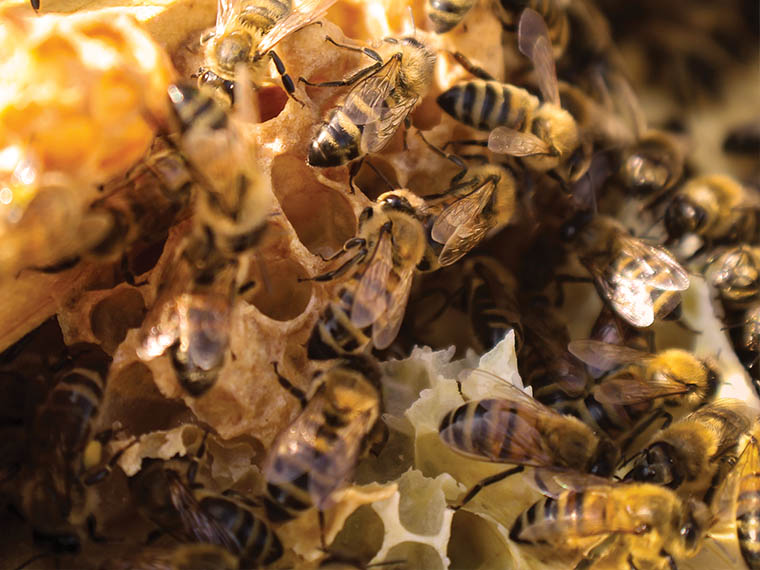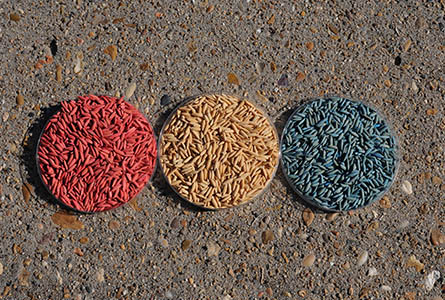The information presented on this page may be dated. It may refer to situations which have changed or people who are no longer affiliated with the university. It is archived as part of Mississippi State University's history.
In the midSouth, early-season pest management is a significant challenge to farmers. For insects, relatively mild winters combined with long, productive growing seasons create an almost perfect environment for their propagation. It is not unusual to see a variety of pest species coexisting at high levels in many fields. Of specific concern to farmers are thrips, bean leaf beetle, three-corner alpha hoppers, and a variety of soil-dwelling insects. In addition to the challenges caused by insects, producers are migrating to earlier planting schedules in an effort to avoid late season drought conditions. The bad news is these earlier planting strategies make the crop more susceptible to soil insects. And increasing inputs to manage herbicide resistant weeds and decreasing commodity prices, force farmers to look at every aspect of their operation to remain profitable.
Neonicotinoids (also known as neonics) are systemic insecticides that are chemically similar to nicotine. The insecticide is absorbed by the plant and circulates through the plant's tissues, killing the insects that feed on them. Unlike contact insecticides, which remain on the surface of the treated foliage, systemic insecticides are taken up by the plant and transported to other plant tissues that may include leaves, flowers, roots, stems, pollen, and nectar depending on the method of application. Products containing neonicotinoids can be applied at the root level, as a seed coating, or sprayed onto crop foliage. The insecticide remains active in the plant for up to four weeks when used as a seed treatment or when applied to the root zone, extending the protection that neonicotinoids provide. In contrast, foliar applications may remain active for only a few days depending on plant size.
A decline in managed pollinators over the last decade led researchers to investigate if neonicotinoids were a contributing factor. This research started in the Midwest and continued more recently in the Midsouth. According to Dr. Jeff Gore, associate extension and research professor of biochemistry, molecular biology, plant pathology and entomology at the MSU Delta Research and Extension Center, entomologists in the Midsouth region of the U.S. were made aware of the impending issues with managed pollinators and neonicotinoid insecticides and were encouraged to take a different approach to pollinator research. Gore and colleagues at Mississippi State University, the University of Arkansas, and the University of Tennessee established collaborative research projects on the potential risks of neonicotinoids to managed pollinators. In addition to the neonicotinoid seed treatments, the entomologists looked at when and where pollinators are exposed to neonicotinoids.
One area that was examined as part of a graduate research project was the residual exhaust from pneumatic planters. It appears that the talc seed lubricant picks up some of the neonicotinoid seed treatment and is exhausted by the planters. These particles were then blown to nearby field edges where pollinators were being exposed to them while foraging. After this research, seed companies and planter manufacturers have given extra attention on how to change their products to address neonicotinoid drift from planters.
Another area of research was conducted to duplicate some of the original studies that were performed in the Midwest, specifically in cotton, soybean, and corn. The conclusions showed no positive detections in cotton pollen or nectar or soybean flowers. Positive detections of the neonicotinoid clothianidin did show up in corn pollen where the insecticide Poncho at the rate of 1250 (the highest labeled rate) was used.
"It is noted that Poncho is not used at this rate in the Midsouth. So at the locally used rates, there is very little if any chance of neonicotinoids ending up in the pollen of cotton, soybean, or corn from their use as seed treatments," Gore said. "We even conducted further studies in rice and determined that neonicotinoids are not showing up in the pollen, flag leaf, or the grain."
Dr. Jeffrey Harris, assistant extension and research professor in biochemistry, molecular biology, plant pathology and entomology, noted that additional research was piloted to determine what would be the best time of day to spray insecticides to have the lowest impact on pollinators.
"The results showed that bees prefer the middle of the day for foraging. So if farmers and aerial applicators can spray later in the day, there would be less bee loss", Harris said. "Even better, if applications occurred in late afternoon, the insecticides would have ample time to break down before the next morning, which would be safer for honey bees."
Harris also recognized that from a practical standpoint, this recommendation sometimes isn't feasible.
"But I have seen many instances where farmers sprayed around high bee population areas with ground rigs (which have more control) and then sprayed the rest of their farm with an airplane. It is also important to remember that bee colonies have a range of up to two miles and can visit as many as 225,000 flowers a day. So no matter how many precautions a farmer might take, in some circumstances, it is up to his neighbor to practice good pollinator stewardship as well," Harris said.
The Midsouth research group also focused on the beneficial side of using neonicotinoids. They combined all of their data from 170 trials conducted on soybean and determined that the use of neonicotinoids as a seed treatment added an average of two additional bushels of grain per acre.
"At first glance, that might not sound like much. But if you consider that the sizes of farms are getting larger, those additional bushels can add up to considerable additional income to a producer, and that can be vital with margins as tight as they are these days," Gore said.
One of the things that are difficult to measure is the hidden benefits of insecticide seed treatments in soybean. Graduate student research has shown that soybean yields are maximized when the crop is planted around April 21.
"For every day planting was delayed after that date, soybean yields decreased by nearly a half a bushel per day," Gore said.
Determining stand loss and the need to replant will often take weeks to decide.
"So if a farmer doesn't use a neonicotinoid seed treatment, incurs significant stand loss from soil insects, and decides to replant three weeks later, then he has potentially lost a little over eight bushels per acre just from a delayed planting date. They can severely penalize themselves by taking the risk of not using neonicotinoid seed treatment, especially in the Midsouth region of the U.S."
Going forward this research group continues to take an open-minded look at both sides of the cost/benefit use of neonicotinoids as well as additional factors that could be affecting pollinators. The scientists will continue to investigate how seed varieties and irrigation practices benefit bees.
"Considering the whole picture, we feel that the risk to pollinators from neonicotinoids is so small; there essentially is no risk in the Midsouth," Gore said. "The Delta environment in the Midsouth is one of the highest use areas for all insecticides on a yearly basis, but this area also has the highest honey production per hive based on the latest USDA estimates. It seems that this would not be the case if the relationships between insecticide use and honey bee decline were as clear as many reports imply."
In the spirit of collaboration, the state's beekeepers and farmers along with industry leaders have formed the Mississippi Honeybee Stewardship Program with leadership from Mississippi Farm Bureau. The emphasis of the program is to foster communication across all lines to mitigate risks to pollinators. The collaboration and setting of standards between beekeepers and farmers have established general guidelines for operation and cooperation. The program is relatively new but already receiving national attention.


